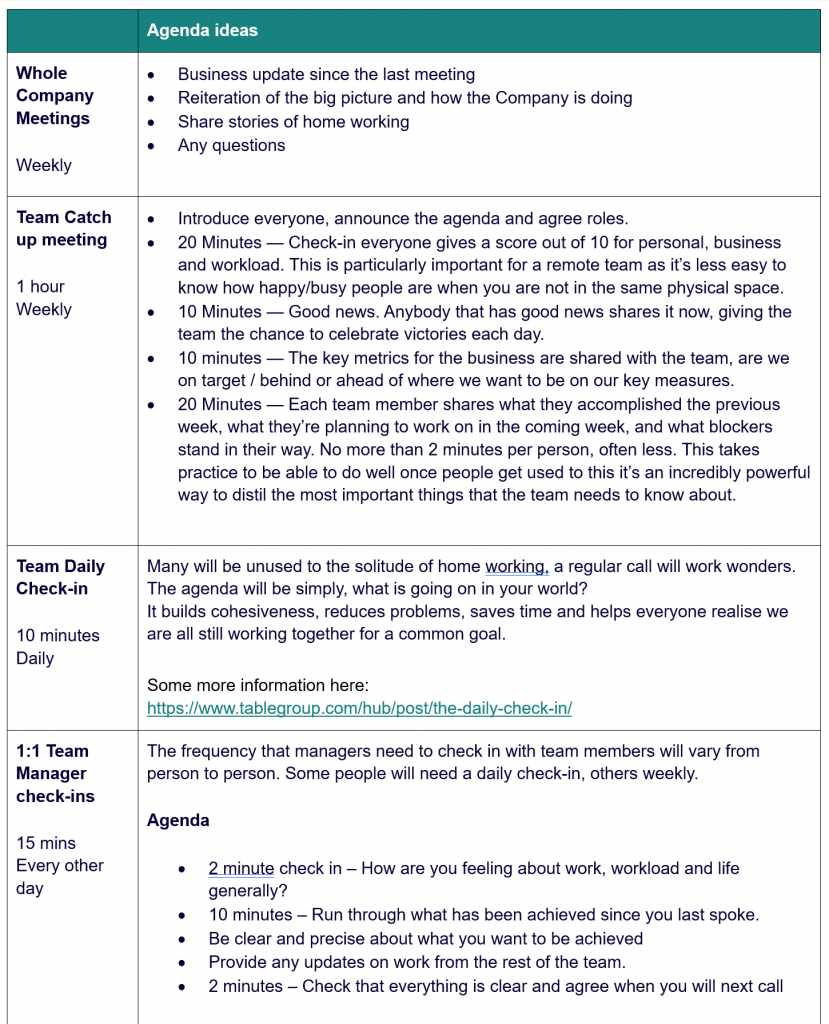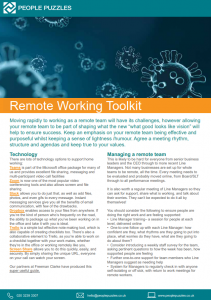Remote Working Toolkit
Keep an emphasis on your remote team being effective and purposeful whilst keeping a sense of lightness/humour. Agree a meeting rhythm, structure and agendas and keep true to your values. Moving rapidly to working as a remote team will have its challenges, however, allowing your remote team to be part of shaping what the new “what good looks like vision” will help to ensure success.
Technology
There are lots of technology options to support home working:
Teams is part of the Microsoft office package for many of us and provides excellent file sharing, messaging and multi-participant video call facilities
Zoom is now one of the most popular video conferencing tools and also allows screen and file sharing
Slack allows you to do just that, as well as add files, photos, and even gifs to every message. Instant messaging services give you all the benefits of email communication, with few of the drawbacks.
Dropbox enables access to your files from anywhere. If you’re the kind of person who’s frequently on the road, the ability to package up what you’ve been working on in the office and take it with you is ideal.
Trello is a simple but effective note-making tool, which is also capable of creating checklists too. There’s also a collaborative element to Trello, as you’re able to work on a checklist together with your workmates, whether they’re in the office or working remotely like you.
Screen Share allows you to do this quickly, easily, and securely. By simply sharing the unique URL, everyone on your call can watch your screen
Our partners at Freeman Clarke have produced this super useful guide.
Managing a Remote Working Team
This is likely to be hard for everyone from senior business leaders and the CEO through to more recent Line Managers. Not many businesses are set up for whole teams to be remote, all the time. Every meeting needs to be evaluated and probably moved online, from Board/SLT through to all performance meetings.
It is also worth a regular meeting of Line Managers so they can ask for support, share what is working, and talk about their worries. They can’t be expected to do it all by themselves!
You should consider the following to ensure people are doing the right work and are feeling supported:
- Line Manager training – a session for people at each level, delivered online.
- One-to-one follow up with each Line Manager: how confident are they, what rhythms are they going to put into place, what worries do they have, what are they going to do about them?
- Consider introducing a weekly staff survey for the team, asking pertinent questions to how the week has been, how supported are people feeling?
- Further one-to-one support for team members who Line Managers suggest as needing help.
- System for Managers to regularly check in with anyone self-isolating or off sick, with return to work meetings for remote workers.
Suggested Meeting Rhythm and Agendas
For businesses new to remote working more, rather than less, contact is encouraged.

General Tips for Running Remote Meetings
- Introduce everyone and announce the agenda. If there are a lot of people in a remote meeting the video camera doesn’t necessarily show every speaker throughout the meeting. The chair should ensure everyone is introduced.
- Checking in on everyone is even more important when you are working together is the same physical space you can see if someone is unhappy or overworked. When a team is working remotely it is easy to miss if someone is drowning in work or stressed. We recommend taking time for each person to update the team on how things are going with business generally, workload and personally.
- Keep the humour and relaxed atmosphere. Icebreakers can work remotely and can really help to create a relaxed atmosphere. Help people feel connected and prevent. You can find some ideas here.
- Agree roles in the meeting:Split the roles between attendees, this is particularly important in a remote meeting or you can end up with everyone talking at once. You generally need a facilitator, timekeeper, and someone to take notes/record actions. This helps involve participants in the meeting. For a recurring meeting consider rotating the roles among participants.
- Set clear expectations and results for the meeting. As with any meeting clarify the reason for the meeting and the outcomes are really important. Don’t end the meeting without making sure that the goal of the meeting is accomplished.
- Ensure the quiet team members have an opportunity to contribute – in remote meetings if someone does not speak they may not even appear on the screen. Before each meeting ends check with all attendees they don’t have anything to add and are clear about agreed actions.
- Ask the notetaker to send a follow-up note. Remind participants about the main points of the meeting. This increases the effectiveness of the meeting and reinforces its importance.
- Check with the team that actions are being progressed. In remote working relationships, it’s vital to clarify and be clear and precise around outcomes and expectations. Discuss expectations during the meeting, follow up via email, and don’t forget to track them after the meeting is over.
Trust Your Team
Most people can trust their teams. If you have any doubts about whether or not the work will get completed at the same level you can set up work-from-home guidelines, such as:
- emails must be responded to within 24 hours,
- use text for urgent matters,
- expectation of answering a call between certain core hours,
- no calls between certain hours to make sure teammates are not working around the clock.
If you are concerned that a member of your team is not working, then you could consider calling unexpectedly from time to time.
Buddy System / Social / Fun
Everyone needs a friend at work.
- Consider a formal or informal Buddy System. Encourage people to face time colleagues that they usually hang out with. Try to recreate some of the informal support network around work.
- WhatsApp can be great for informal comms, if employees are happy to share mobile numbers (need permission #GDPR!)
- Ask the team to come up with ideas for a daily or weekly challenge, such as sharing a photo of a workstation “Guess who works there?”, or similar. Give someone the role of WFH connector.
- Consider how your values are recognised in how people work from home. What can you reward? How can you share the news?
Employee Wellbeing
This could be a difficult and stressful time for your team, there is useful advice here.
Consider introducing a WFH wellbeing policy, resilience training or a resilience guide. Team members could share what is working well and what isn’t, and you can build up some useful ideas to circulate around the wider business.
What should team members do if they are worried about someone?
- Talk to their Line Manager
- Talk to the People Director
The practicalities
It is a company’s job to ensure that people are safe to work from home. This is quite tricky when it is a quick reaction to Coronavirus rather than a planned event. Encourage people to think about:
- Risk assessments
- Home workstations
- Hygiene at home
- LinkedIn has a whole host of videos to help people working from home here.
- Consider how you can keep open lines of communication with the team to support them and uncover issues.
And when you are ready to think about reopening your workplace again check out our checklist of questions to ask yourself first.



